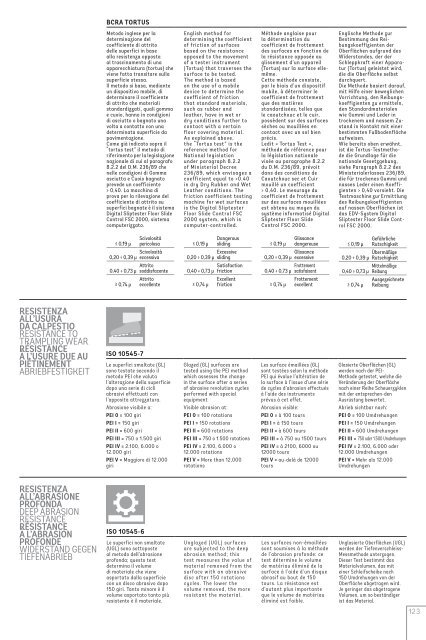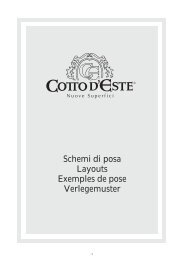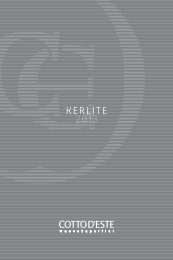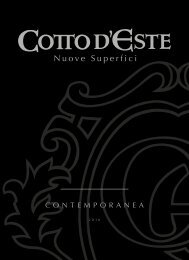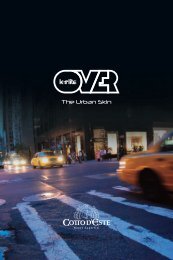Catalogo Contemporanea (PDF) - Padimat
Catalogo Contemporanea (PDF) - Padimat
Catalogo Contemporanea (PDF) - Padimat
You also want an ePaper? Increase the reach of your titles
YUMPU automatically turns print PDFs into web optimized ePapers that Google loves.
BCRA TORTUS<br />
Metodo inglese per la<br />
determinazione del<br />
coefficiente di attrito<br />
delle superfici in base<br />
alla resistenza opposta<br />
al trascinamento di una<br />
apparecchiatura (tortus) che<br />
viene fatta transitare sulla<br />
superficie stessa.<br />
Il metodo si basa, mediante<br />
un dispositivo mobile, di<br />
determinare il coefficiente<br />
di attrito che materiali<br />
standardizzati, quali gomma<br />
e cuoio, hanno in condizioni<br />
di asciutto o bagnato una<br />
volta a contatto con una<br />
determinata superficie da<br />
pavimentazione.<br />
Come già indicato sopra il<br />
“tortus test” il metodo di<br />
riferimento per la legislazione<br />
nazionale di cui al paragrafo<br />
8.2.2 del D.M. 236/89 che<br />
nelle condizioni di Gomma<br />
asciutta e Cuoio bagnato<br />
prevede un coefficiente<br />
> 0,40. La macchina di<br />
prova per la rilevazione del<br />
coefficiente di attrito su<br />
superfici bagnate è il sistema<br />
Digital Sliptester Floor Slide<br />
Control FSC 2000, sistema<br />
computerizzato.<br />
English method for<br />
determining the coefficient<br />
of friction of surfaces<br />
based on the resistance<br />
opposed to the movement<br />
of a tester instrument<br />
(Tortus) that traverses the<br />
surface to be tested.<br />
The method is based<br />
on the use of a mobile<br />
device to determine the<br />
coefficient of friction<br />
that standard materials,<br />
such as rubber and<br />
leather, have in wet or<br />
dry conditions further to<br />
contact with a certain<br />
floor covering material.<br />
As explained above,<br />
the “Tortus test” is the<br />
reference method for<br />
National legislation<br />
under paragraph 8.2.2<br />
of Ministerial Decree<br />
236/89, which envisages a<br />
coefficient equal to >0.40<br />
in dry Dry Rubber and Wet<br />
Leather conditions. The<br />
friction coefficient testing<br />
machine for wet surfaces<br />
is the Digital Sliptester<br />
Floor Slide Control FSC<br />
2000 system, which is<br />
computer-controlled.<br />
Méthode anglaise pour<br />
la détermination du<br />
coefficient de frottement<br />
des surfaces en fonction de<br />
la résistance opposée au<br />
glissement d’un appareil<br />
(Tortus) sur la surface ellemême.<br />
Cette méthode consiste,<br />
par le biais d’un dispositif<br />
mobile, à déterminer le<br />
coefficient de frottement<br />
que des matières<br />
standardisées, telles que<br />
le caoutchouc et le cuir,<br />
possèdent sur des surfaces<br />
sèches ou mouillées en<br />
contact avec un sol bien<br />
précis.<br />
Ledit « Tortus Test »,<br />
méthode de référence pour<br />
la législation nationale<br />
visée au paragraphe 8.2.2<br />
du D.M. 236/89, prévoit<br />
dans des conditions de<br />
Caoutchouc sec et Cuir<br />
mouillé un coefficient<br />
> 0,40. Le mesurage du<br />
coefficient de frottement<br />
sur des surfaces mouillées<br />
est obtenu au moyen du<br />
système informatisé Digital<br />
Sliptester Floor Slide<br />
Control FSC 2000.<br />
Englische Methode zur<br />
Bestimmung des Reibungskoeffizienten<br />
der<br />
Oberflächen aufgrund des<br />
Widerstandes, der der<br />
Schleppkraft einer Apparatur<br />
(Tortus) geleistet wird,<br />
die die Oberfläche selbst<br />
durchquert.<br />
Die Methode basiert darauf,<br />
mit Hilfe einer beweglichen<br />
Vorrichtung, den Reibungskoeffizienten<br />
zu ermitteln,<br />
den Standardmaterialen<br />
wie Gummi und Leder in<br />
trockenem und nassem Zustand<br />
in Kontakt mit einer<br />
bestimmten Fußbodenfläche<br />
aufweisen.<br />
Wie bereits oben erwähnt,<br />
ist die Tortus-Testmethode<br />
die Grundlage für die<br />
nationale Gesetzgebung,<br />
siehe Paragraph 8.2.2 des<br />
Ministerialerlasses 236/89,<br />
die für trockenes Gummi und<br />
nasses Leder einen Koeffizienten<br />
> 0,40 vorsieht. Die<br />
Testmaschine zur Ermittlung<br />
des Reibungskoeffizienten<br />
auf nassen Oberflächen ist<br />
das EDV-System Digital<br />
Sliptester Floor Slide Control<br />
FSC 2000.<br />
Scivolosità<br />
≤ 0,19 µ pericolosa<br />
0,20 ÷ 0,39 µ Scivolosità<br />
eccessiva<br />
0,40 ÷ 0,73 µ Attrito<br />
soddisfacente<br />
Attrito<br />
≥ 0,74 µ eccellente<br />
Dangerous<br />
≤ 0,19 µ sliding<br />
0,20 ÷ 0,39 µ Excessive<br />
sliding<br />
0,40 ÷ 0,73 µ Satisfaction<br />
friction<br />
Excellent<br />
≥ 0,74 µ friction<br />
Glissance<br />
≤ 0,19 µ dangereuse<br />
0,20 ÷ 0,39 µ Glissance<br />
excessive<br />
0,40 ÷ 0,73 µ Frottement<br />
satisfaisant<br />
Frottement<br />
≥ 0,74 µ excellent<br />
Gefährliche<br />
≤ 0,19 µ Rutschigkeit<br />
0,20 ÷ 0,39 µ Übermäßige<br />
Rutschigkeit<br />
0,40 ÷ 0,73 µ Mittelmäßige<br />
Reibung<br />
Ausgezeichnete<br />
≥ 0,74 µ Reibung<br />
RESISTENZA<br />
ALL’USURA<br />
DA CALPESTIO<br />
RESISTANCE TO<br />
TRAMPLING WEAR<br />
RÉSISTANCE<br />
À L’USURE DUE AU<br />
PIÉTINEMENT<br />
ABRIEBFESTIGKEIT<br />
ISO 10545-7<br />
Le superfici smaltate (GL)<br />
sono testate secondo il<br />
metodo PEI che valuta<br />
l’alterazione della superficie<br />
dopo una serie di cicli<br />
abrasivi effettuati con<br />
l’apposita attrezzatura.<br />
Abrasione visibile a:<br />
PEI 0 = 100 giri<br />
PEI I = 150 giri<br />
PEI II = 600 giri<br />
PEI III = 750 o 1.500 giri<br />
PEI IV = 2.100, 6.000 o<br />
12.000 giri<br />
PEI V = Maggiore di 12.000<br />
giri<br />
Glazed (GL) surfaces are<br />
tested using the PEI method<br />
which assesses the change<br />
in the surface after a series<br />
of abrasive revolution cycles<br />
performed with special<br />
equipment<br />
Visible abrasion at:<br />
PEI 0 = 100 rotations<br />
PEI I = 150 rotations<br />
PEI II = 600 rotations<br />
PEI III = 750 o 1.500 rotations<br />
PEI IV = 2.100, 6.000 o<br />
12.000 rotations<br />
PEI V = More than 12,000<br />
rotations<br />
Les surface émaillées (GL)<br />
sont testées selon la méthode<br />
PEI qui évalue l’altération de<br />
la surface à l’issue d’une série<br />
de cycles d’abrasion effectués<br />
à l’aide des instruments<br />
prévus à cet effet.<br />
Abrasion visible:<br />
PEI 0 = à 100 tours<br />
PEI I = à 150 tours<br />
PEI II = à 600 tours<br />
PEI III = à 750 ou 1500 tours<br />
PEI IV = à 2100, 6000 ou<br />
12000 tours<br />
PEI V = au-delà de 12000<br />
tours<br />
Glasierte Oberflächen (GL)<br />
werden nach der PEI-<br />
Methode getestet, welche die<br />
Veränderung der Oberfläche<br />
nach einer Reihe Scheuerzyklen<br />
mit der entsprechen-den<br />
Ausrüstung bewertet.<br />
Abrieb sichtbar nach:<br />
PEI 0 = 100 Umdrehungen<br />
PEI I = 150 Umdrehungen<br />
PEI II = 600 Umdrehungen<br />
PEI III = 750 oder 1.500 Umdrehungen<br />
PEI IV = 2.100, 6.000 oder<br />
12.000 Umdrehungen<br />
PEI V = Mehr als 12.000<br />
Umdrehungen<br />
RESISTENZA<br />
ALL’ABRASIONE<br />
PROFONDA<br />
DEEP ABRASION<br />
RESISTANCE<br />
RÉSISTANCE<br />
À L’ABRASION<br />
PROFONDE<br />
WIDERSTAND GEGEN<br />
TIEFENABRIEB<br />
ISO 10545-6<br />
Le superfici non smaltate<br />
(UGL) sono sottoposte<br />
al metodo dell’abrasione<br />
profonda; questo test<br />
determina il volume<br />
di materiale che viene<br />
asportato dalla superficie<br />
con un disco abrasivo dopo<br />
150 giri. Tanto minore è il<br />
volume asportato tanto più<br />
resistente è il materiale.<br />
Unglazed (UGL) surfaces<br />
are subjected to the deep<br />
abrasion method; this<br />
test measures the value of<br />
material removed from the<br />
surface with an abrasive<br />
disc after 150 rotations<br />
cycles. The lower the<br />
volume removed, the more<br />
resistant the material.<br />
Les surfaces non-émaillées<br />
sont soumises à la méthode<br />
de l’abrasion profonde: ce<br />
test détermine le volume<br />
de matériau éliminé de la<br />
surface à l’aide d’un disque<br />
abrasif au bout de 150<br />
tours. La résistance est<br />
d’autant plus importante<br />
que le volume de matériau<br />
éliminé est faible.<br />
Unglasierte Oberflächen (UGL)<br />
werden der Tiefenverschleiss-<br />
Messmethode unterzogen.<br />
Dieser Test bestimmt das<br />
Materialvolumen, das mit<br />
einer Schleifscheibe nach<br />
150 Umdrehungen von der<br />
Oberfläche abgetragen wird.<br />
Je geringer das abgetragene<br />
Volumen, um so beständiger<br />
ist das Material.<br />
123


